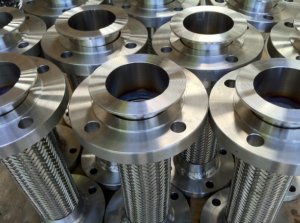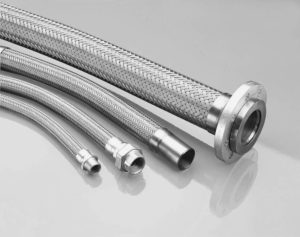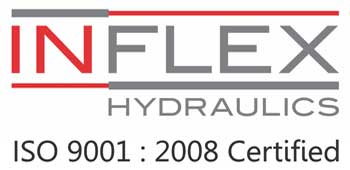Stainless Steel Hose
Stainless steel hoses are one of the most reliable options for a secure and durable hose system. Whether you’re looking to upgrade an existing setup or install a new system, stainless steel hoses have many advantages that make them desirable. From their durability to resistance against corrosion, these hoses provide exceptional value and performance. Let’s take a closer look at why they should be your go-to choice when it comes to hydraulic hose solutions.
When it comes to durability, stainless steel is hard to beat. It’s ideal for use in high pressure environments as well as areas exposed to extreme temperatures and weather conditions. With its superior construction, you can rest assured that your installation will remain intact despite whatever Mother Nature throws at it! Additionally, this material won’t corrode over time; so you don’t need to worry about replacing your hose anytime soon.
Finally, installing stainless steel hoses is relatively straightforward compared with other materials like PVC or rubber. They require minimal maintenance and repairs which saves both time and money in the long run. So if you’re looking for a dependable solution that requires little upkeep then stainless steel might be the right fit for you!

Characteristics Of Stainless Steel Hoses
Stainless steel hoses offer a range of properties that make them ideal for countless industrial applications. They are temperature resistant, corrosion resistant, and possess high pressure ratings. Their flexibility also makes them easy to install in most settings. Temperature resistance is one of the primary characteristics of stainless steel hose material. It can withstand temperatures from -196°C up to 593°C without any loss of integrity or performance. This makes it an excellent choice for use in high heat environments such as engines, boilers, furnaces and more. Corrosion-resistance is another key property of stainless steel hoses; they will not rust or corrode when exposed to water or other liquids.
Additionally, their pressure rating ensures they are able to handle many different types of liquid with ease and reliability over time. With these impressive characteristics combined, stainless steel hoses provide reliable performance over long periods while still being easy to maintain. By transitioning between sections smoothly at the end of this paragraph readers can now better understand why there are so many advantages associated with using stainless steel hoses.
Advantages Of Using Stainless Steel Hoses
Stainless steel hoses offer many advantages over traditional rubber or plastic hoses. Most notably, stainless steel is highly durable and offers superior corrosion resistance which makes it an excellent choice for outdoor applications. Additionally, stainless steel hoses are odor resistant, providing a more pleasant experience when installed indoors.
In addition to being extremely durable, stainless steel also offers good high-temperature resistance. This allows users to use the hose in a wide variety of settings without having to worry about the hose becoming damaged due to extreme temperatures. Furthermore, because stainless steel is so strong, it can be bent and formed into shapes that make installation easier and more flexible compared to other materials.
Overall, using a stainless steel hose provides numerous benefits that help ensure its longevity and performance in even the harshest environments. These characteristics make them ideal for both residential and commercial uses where durability and corrosion-resistance are paramount considerations. With these advantages in mind, it’s easy to see why so many people choose stainless steel hoses as their preferred material over other types of hoses on the market today.
The next section will discuss the various types of stainless steel hoses available on the market today including braided metal hose assemblies, corrugated metal tubes, and interlocking flex pipes among others. Each type has its own unique features designed to meet specific needs depending on application requirements such as strength, flexibility, pressure rating and temperature range.
Types Of Stainless Steel Hoses
Are you looking for the right type of hose to use in your application? Stainless steel hoses are a great option, as they offer several benefits and come in various types. Here is an overview of some common types:
Corrugated- Corrugated stainless steel hoses are extremely flexible, making them ideal for tight spaces or applications that require frequent movement. They also have a good range of motion and can be used with most liquids.
Flexible – Flexible stainless steel hoses are designed to bend and move easily without kinking or breaking. They’re often reinforced with double-braided fabric, which adds strength and durability while still allowing them to remain lightweight and easy to maneuver.
Reinforced/Double-Braided – Reinforced or double-braided stainless steel hoses are more durable than other types, thanks to their two layers of interlocked strands. This makes them well suited for high pressure applications where extra strength is needed.
Stainless steel hoses provide many advantages over rubber or plastic options, making them a popular choice for industrial settings. Knowing the different types available allows you to choose the best one for your particular needs. With careful consideration of size and length, it’s possible to find the perfect hose for any application!
Selecting The Right Size And Length For Your Application
When selecting a stainless steel hose, size and length are essential considerations. It is important to select the right size and length for your application needs. The right fit will ensure that you get the most out of your hose in terms of optimal performance.
The first step in choosing the right size and length for your hose is to determine what diameter you need. This can be done by measuring the inside diameter of an existing hose or consulting with a specialist who can recommend the best options based on your requirements. Once this has been established, it’s time to start considering other factors like pressure rating, working temperature, and weight capacity when deciding which type of stainless steel hose is best suited for your application.
Length selection should also be taken into consideration when picking a suitable stainless steel hose. If you require extra flexibility, then opting for a longer hose may be beneficial as it allows more freedom of movement while being used. Additionally, if there are tight spaces where you plan to use the hose, make sure that its length won’t put too much strain on any part of the system or cause kinking issues down the line. By taking all these details into account when making your decision, you can find just the right size and length for your particular project needs.
With proper sizing and length selection complete, you’re ready to move on to choosing the best fittings for your needs.Choosing The Best Fittings For Your Needs
Much like the perfect finishing touch to a well-crafted outfit, selecting the right fittings for your stainless steel hose is essential. After all, what use is having high quality material if it’s not complemented with appropriate attachments? Fortunately, there are a variety of fitting sizes and options available on the market that make finding an ideal match easier than ever before. Here are some guidelines you should consider when choosing the best fittings:
Look at compatibility: Make sure you select fittings that will properly fit the type of stainless steel hose you’re using.
Consider size: Fittings come in multiple sizes, so be sure to pick one that won’t overwhelm or underwhelm your tube diameter.
Think about style: From swivel nuts to elbows, ensure your chosen fitting correctly reflects your desired aesthetic.
Having knowledge of these three points can help you narrow down which fitting option works best for you. With this information in mind, carefully examining each potential choice becomes simpler and more efficient – ultimately helping you save time and money while achieving optimal results. Understanding how to choose suitable fittings is central to getting maximum performance out of any stainless steel hose system. Armed with this expertise, transitioning into exploring common applications for stainless steel hoses starts feeling like second nature.
Common Applications For Stainless Steel Hoses
Stainless steel hoses are widely used in a variety of industries and applications for their excellent corrosion resistance, flexibility, strength, durability, and chemical compatibility. In the marine industry, stainless steel hose provides superior protection against saltwater exposure. It’s also an ideal material for industrial grade water supply lines due to its ability to resist extreme temperatures and even kinking when bent.
In addition to these uses, stainless steel hoses have become increasingly popular in many other areas including chemical processing plants where they can handle hazardous liquids with ease. They’re also commonly found in beverage manufacturing facilities because of their hygienic properties as well as being able to withstand high pressures and caustic chemicals.
Finally, it’s important to note that flexible stainless steel hoses are becoming more commonplace across various commercial settings such as automotive repair shops or retail stores where they are often used for air conditioning systems or gas delivery systems respectively. The versatility of stainless steels makes them an essential component for many different environments requiring a reliable solution for liquid transportation needs.
Material Properties of Stainless Steel Hose Assemblies
Choose the right SS Hose assembly for your industry
SS Hose assembly – Essential components
SS Hose assembly – comparisons
Problems with SS Hoses and Solutions
Using SS Hose in challenging conditions
Are Stainless Steel Hoses Safe For Drinking Water?
Stainless steel has become a common material for many products, and hoses are no exception. But with the use of stainless steel in drinking water systems comes an important question: are they safe? With its reputation as a corrosion-resistant metal, it’s understandable why some might think using stainless steel is the way to go. However, there are certain risks associated with this type of hose that must be considered before making any decisions about its usage.
First and foremost, the potential chemical contamination of your water supply should be taken into account when deciding if stainless steel hoses are suitable for your needs. Even though these materials are resistant to rusting and other forms of damage, they can still leach impurities into your water over time due to their porous nature. This could lead to problems such as digestive discomfort or even more serious health issues depending on what chemicals were released from the hose.
When considering whether stainless steel hoses are safe for drinking water, some additional factors should also be kept in mind:
* The quality of the installation – if not done correctly then contaminants may seep through imperfections in the seal;
* The longevity of the product – how long will it last without needing replacement;
* Regular maintenance & cleaning – how often do you need to check up on them and make sure everything is working properly?
In order to ensure that you get maximum safety and peace of mind while using stainless steel hoses for your drinking water system, proper research beforehand is key. Figure out which types would work best for you based on their characteristics and evaluate all potential risks involved. Don’t forget to factor in your budget too! By taking precautions like these ahead of time, you’ll have greater assurance that your family is getting clean, healthy water every day.
How Often Should Stainless Steel Hoses Be Replaced?
When it comes to maintaining the safety and performance of our fixtures and appliances, choosing the right hose is essential. But how often should a stainless steel hose be replaced? To answer this question, we need to look at its lifespan, replacement frequency, and other factors that can affect its longevity.
The average lifespan of a stainless steel hose is around five years – though you may find some lasting much longer depending on usage. It’s important to inspect your hoses regularly for signs of wear or damage such as rusting, kinking, cracking, leaking or bulging. If any of these issues are present, then it’s time to replace your hose with a new one.
Here are four key things to consider when replacing a stainless steel hose:
- Look for quality materials when selecting your new stainless steel hose;
- Ensure that the connection size is compatible with your appliance;
- Check for any leaks before using the hose; and
- Make sure that all parts are secured tightly in place after installation.
Taking these steps will help ensure that your stainless steel hose lasts as long as possible and performs optimally over time. Regular inspections combined with proper maintenance will also help keep your appliance running smoothly without needing unnecessary replacements too soon!
How Can I Prevent Corrosion Of Stainless Steel Hoses?
Corrosion is one of the biggest threats to any type of metal and it’s no different when it comes to stainless steel. Taking steps now to protect your hoses from corrosion will ensure that they stay in top condition for years to come. Here are some tips on how you can effectively prevent corrosion of stainless steel hoses:
* Use a rust-resistant coating or wrap before installing them, as this will provide an extra layer of protection against moisture and other elements that cause corrosion.
* Clean and inspect the hose regularly by using a brush or rag with soap and water, then thoroughly dry before reattaching it.
* Make sure the hose is properly connected and sealed so that no air or liquids can get into contact with the metal surface. This will reduce the risk of oxidation occurring over time due to exposure to oxygen and humidity.
* Consider investing in anti-corrosive lubricants which help keep the interior walls clean and free from deposits that might otherwise damage the material.
These preventive measures should be taken as soon as possible because once corrosion has set in, there is often little hope for repair without costly replacement. Keep in mind too that even if these methods don’t completely eliminate all traces of corrosion, they may still slow down its progression enough so that it won’t become a major problem anytime soon – saving you both money and headaches down the road. It’s also important to understand that proper maintenance practices such as regular cleaning, inspection, sealing etc., are essential for keeping your stainless steel hoses safe from potential harm caused by corrosive agents like saltwater or acid rain. With these guidelines firmly in place, you can rest assured knowing your investment is being well looked after!
Can Stainless Steel Hoses Be Used In High-Temperature Applications?
When considering a new hose for use in high-temperature applications, stainless steel is often at the top of the list. It’s known for its superior strength and corrosion resistance, making it an ideal material for those tough jobs. But what about using stainless steel hoses? Are they able to withstand these high temperatures without damage or degradation?
The answer is yes! Stainless steel hoses are designed specifically with heat resistance in mind. They can handle extreme temperatures up to 600 degrees Fahrenheit without melting or failing. This makes them perfect for use in areas such as heavy industrial processes where there is a risk of fire due to sparks and other hot materials coming into contact with the hose. Additionally, their chemical resistance allows them to be used in environments that contain corrosive materials like acids and alkalis without suffering damage.
These features make stainless steel hoses highly desirable when compared to other types of hoses. They offer reliable performance under harsh conditions while providing peace of mind knowing that your equipment won’t suffer from premature wear and tear due to temperature extremes or exposure to hazardous chemicals. Whether you’re looking for something durable enough to stand up against the heat or something resistant enough to protect your machines from corrosive substances, stainless steel hoses should fit the bill perfectly.
Are Stainless Steel Hoses Resistant To Chemical Damage?
Imagine a shield of protection, resiliently blocking out any harm from the outside world. This is what stainless steel hoses offer when it comes to chemical damage. With their impressive chemical-resistance, these hoses are like an impenetrable fortress against harsh chemicals and corrosion.
Chemical durability is a major benefit that stainless steel hoses bring; they provide reliable long-term protection by preventing any kind of corrosive damage or leaking. Not only do they protect your equipment from costly repairs, but they also ensure safety in hazardous environments where exposure to certain chemicals can be dangerous.
The robust construction of stainless steel hoses makes them ideal for protecting against various types of chemical damage such as acidity, alkalinity, and oxidation. Their superior chemical-protection gives users peace of mind knowing their assets are safe and secure even in extreme conditions with high levels of exposure to damaging substances. Combined with their versatility and affordability, stainless steel hoses make an excellent choice for anyone looking for effective chemical-corrosion prevention and defense against potential hazards.
So whether you need dependable protection in industrial settings or simply want assurance that your pipes will remain strong through time – stainless steel hoses are the answer! With unmatched strength and reliability, these hardworking solutions have been trusted for generations to keep people safe from harmful chemicals and unforeseen damages alike.
Conclusion
In conclusion, Stainless steel hoses also provide reliable performance even in extreme temperature conditions. This makes them perfect for industrial use where temperatures may be significantly higher than normal settings. With such versatile properties, stainless steel hoses truly stand out as one of the best options available today – no matter what your needs may be!

